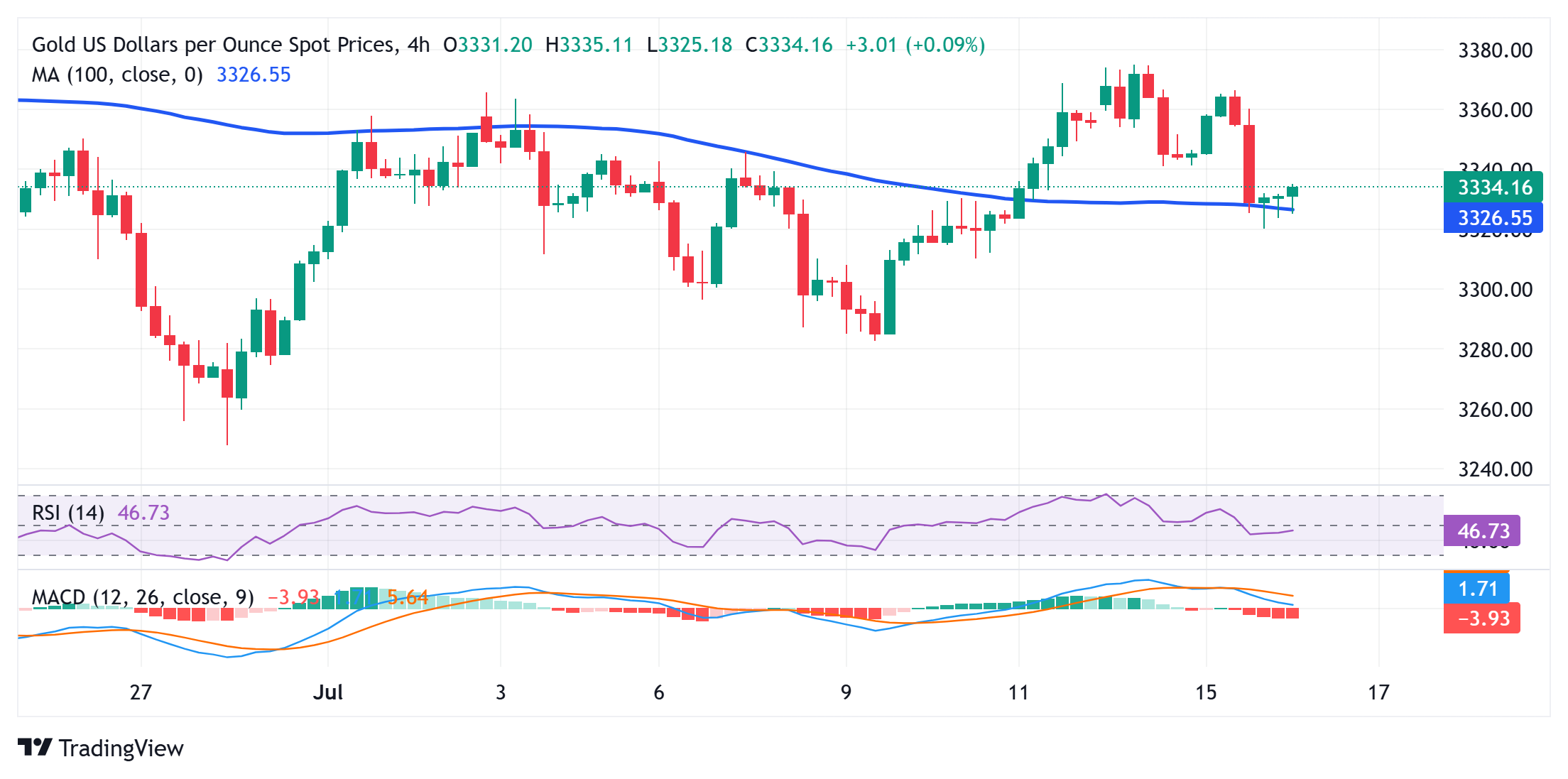Created
: 2025.07.16














![]() 2025.07.16 13:13
2025.07.16 13:13
Gold price (XAU/USD) edges higher during the Asian session on Wednesday and reverses a part of the overnight downfall to a multi-day low, though it lacks follow-through buying. Against the backdrop of persistent uncertainties over US President Donald Trump's trade tariffs, bets that the Federal Reserve (Fed) will keep interest rates elevated temper investors' appetite for riskier assets. This is evident from a weaker tone around the equity markets and turns out to be a key factor lending some support to the safe-haven precious metal.
Meanwhile, the US Dollar (USD) pauses for a breather following Tuesday's blowout rally to its highest level since June 23 and further benefits the Gold price. However, expectations that the Fed would delay cutting interest rates, amid a slight pickup in US inflation, act as a tailwind for the USD and might hold back traders from placing aggressive bullish bets around the non-yielding yellow metal. This warrants caution before positioning for any further appreciating move as traders now look to the US Producer Price Index (PPI) for a fresh impetus.

From a technical perspective, the commodity shows some resilience below the 100-period Simple Moving Average (SMA) on the 4-hour chart and, for now, seems to have stalled the retracement slide from a three-week top touched on Monday. That said, oscillators on the said chart are yet to confirm bullish bias and warrant some caution before positioning for further gains. Hence, any subsequent move up might confront an immediate hurdle near the $3,342-3,343 region, above which the Gold price could retest the $3,365-3,366 horizontal barrier. Some follow-through buying, however, would set the stage for a move towards reclaiming the $3,400 round figure.
On the flip side, weakness below the $3,320 area, or the weekly trough touched on Tuesday, is more likely to find decent support near the $3,300 round figure. This is followed by the $3,283-3,282 region, or over a one-week low touched last Tuesday, which, if broken, would make the Gold price vulnerable to accelerate the corrective fall towards the July swing low, around the $3,248-3,247 zone.
Monetary policy in the US is shaped by the Federal Reserve (Fed). The Fed has two mandates: to achieve price stability and foster full employment. Its primary tool to achieve these goals is by adjusting interest rates. When prices are rising too quickly and inflation is above the Fed's 2% target, it raises interest rates, increasing borrowing costs throughout the economy. This results in a stronger US Dollar (USD) as it makes the US a more attractive place for international investors to park their money. When inflation falls below 2% or the Unemployment Rate is too high, the Fed may lower interest rates to encourage borrowing, which weighs on the Greenback.
The Federal Reserve (Fed) holds eight policy meetings a year, where the Federal Open Market Committee (FOMC) assesses economic conditions and makes monetary policy decisions. The FOMC is attended by twelve Fed officials - the seven members of the Board of Governors, the president of the Federal Reserve Bank of New York, and four of the remaining eleven regional Reserve Bank presidents, who serve one-year terms on a rotating basis.
In extreme situations, the Federal Reserve may resort to a policy named Quantitative Easing (QE). QE is the process by which the Fed substantially increases the flow of credit in a stuck financial system. It is a non-standard policy measure used during crises or when inflation is extremely low. It was the Fed's weapon of choice during the Great Financial Crisis in 2008. It involves the Fed printing more Dollars and using them to buy high grade bonds from financial institutions. QE usually weakens the US Dollar.
Quantitative tightening (QT) is the reverse process of QE, whereby the Federal Reserve stops buying bonds from financial institutions and does not reinvest the principal from the bonds it holds maturing, to purchase new bonds. It is usually positive for the value of the US Dollar.
![]()
Created
: 2025.07.16
![]()
Last updated
: 2025.07.16

FXStreet is a forex information website, delivering market analysis and news articles 24/7.
It features a number of articles contributed by well-known analysts, in addition to the ones by its editorial team.
Founded in 2000 by Francesc Riverola, a Spanish economist, it has grown to become a world-renowned information website.
We hope you find this article useful. Any comments or suggestions will be greatly appreciated.
We are also looking for writers with extensive experience in forex and crypto to join us.
please contact us at [email protected].
Disclaimer:
All information and content provided on this website is provided for informational purposes only and is not intended to solicit any investment. Although all efforts are made in order to ensure that the information is correct, no guarantee is provided for the accuracy of any content on this website. Any decision made shall be the responsibility of the investor and Myforex does not take any responsibility whatsoever regarding the use of any information provided herein.
The content provided on this website belongs to Myforex and, where stated, the relevant licensors. All rights are reserved by Myforex and the relevant licensors, and no content of this website, whether in full or in part, shall be copied or displayed elsewhere without the explicit written permission of the relevant copyright holder. If you wish to use any part of the content provided on this website, please ensure that you contact Myforex.
Myforex uses cookies to improve the convenience and functionality of this website. This website may include cookies not only by us but also by third parties (advertisers, log analysts, etc.) for the purpose of tracking the activities of users. Cookie policy